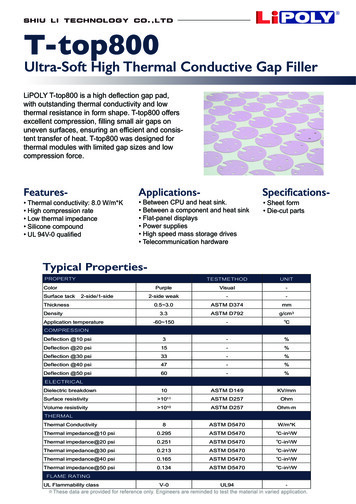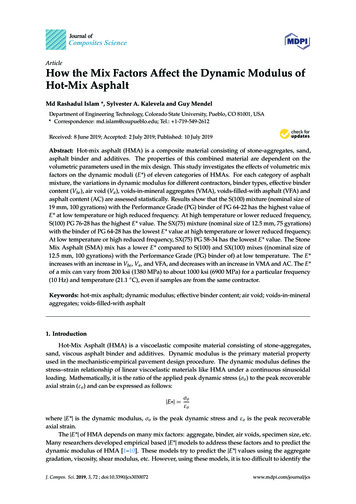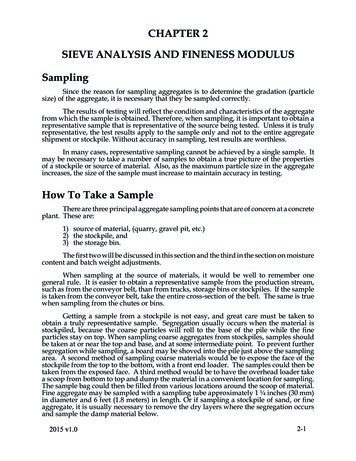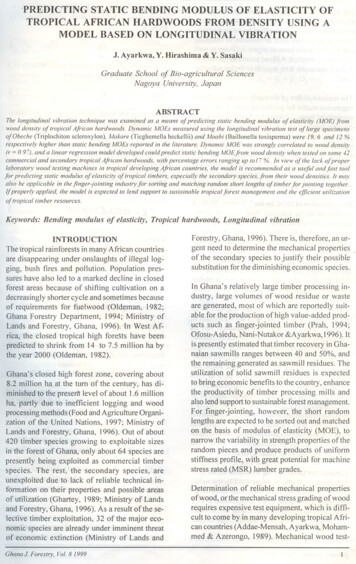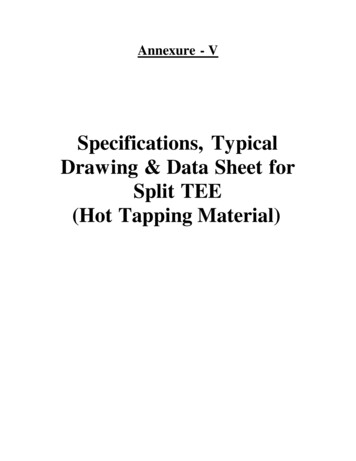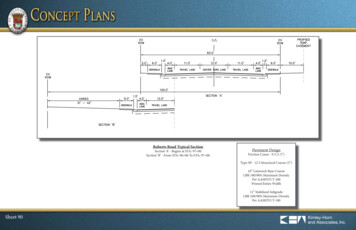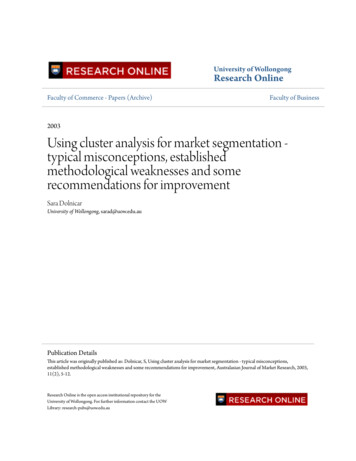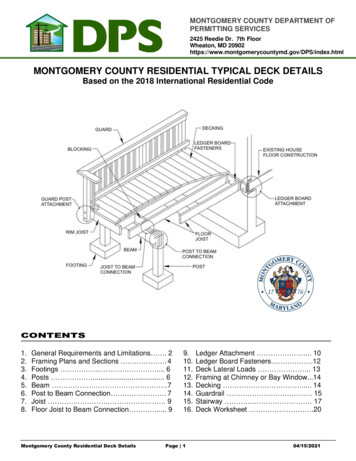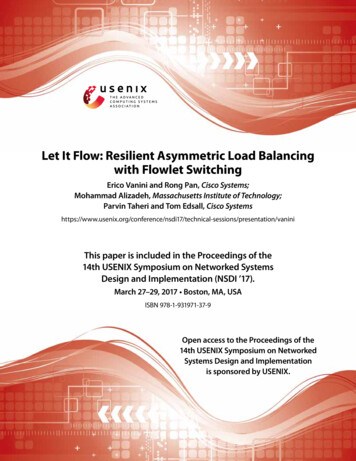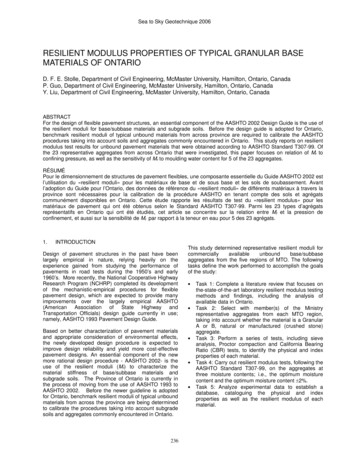
Transcription
Sea to Sky Geotechnique 2006RESILIENT MODULUS PROPERTIES OF TYPICAL GRANULAR BASEMATERIALS OF ONTARIOD. F. E. Stolle, Department of Civil Engineering, McMaster University, Hamilton, Ontario, CanadaP. Guo, Department of Civil Engineering, McMaster University, Hamilton, Ontario, CanadaY. Liu, Department of Civil Engineering, McMaster University, Hamilton, Ontario, CanadaABSTRACTFor the design of flexible pavement structures, an essential component of the AASHTO 2002 Design Guide is the use ofthe resilient moduli for base/subbase materials and subgrade soils. Before the design guide is adopted for Ontario,benchmark resilient moduli of typical unbound materials from across province are required to calibrate the AASHTOprocedures taking into account soils and aggregates commonly encountered in Ontario. This study reports on resilientmodulus test results for unbound pavement materials that were obtained according to AASHTO Standard T307-99. Ofthe 23 representative aggregates from across Ontario that were investigated, this paper focuses on relation of Mr toconfining pressure, as well as the sensitivity of Mr to moulding water content for 5 of the 23 aggregates.RÉSUMÉPour le dimensionnement de structures de pavement flexibles, une composante essentielle du Guide AASHTO 2002 estl’utilisation du «resilient moduli» pour les matériaux de base et de sous base et les sols de soubassement. Avantl’adoption du Guide pour l’Ontario, des données de référence du «resilient moduli» de différents matériaux à travers laprovince sont nécessaires pour la calibration de la procédure AASHTO en tenant compte des sols et agrégatscommunément disponibles en Ontario. Cette étude rapporte les résultats de test du «resilient modulus» pour lesmatériaux de pavement qui ont été obtenus selon le Standard AASHTO T307-99. Parmi les 23 types d’agrégatsreprésentatifs en Ontario qui ont été étudiés, cet article se concentre sur la relation entre Mr et la pression deconfinement, et aussi sur la sensibilité de Mr par rapport à la teneur en eau pour 5 des 23 agrégats.1.INTRODUCTIONDesign of pavement structures in the past have beenlargely empirical in nature, relying heavily on theexperience gained from studying the performance ofpavements in road tests during the 1950’s and early1960’s. More recently, the National Cooperative HighwayResearch Program (NCHRP) completed its developmentof the mechanistic-empirical procedures for flexiblepavement design, which are expected to provide manyimprovements over the largely empirical AASHTO(American Association of State Highway andTransportation Officials) design guide currently in use;namely, AASHTO 1993 Pavement Design Guide.Based on better characterization of pavement materialsand appropriate consideration of environmental effects,the newly developed design procedure is expected toimprove design reliability and yield more cost-effectivepavement designs. An essential component of the newmore rational design procedure - AASHTO 2002- is theuse of the resilient moduli (Mr) to characterize thematerial stiffness of base/subbase materials andsubgrade soils. The Province of Ontario is currently inthe process of moving from the use of AASHTO 1993 toAASHTO 2002. Before the newer guideline is adoptedfor Ontario, benchmark resilient moduli of typical unboundmaterials from across the province are being determinedto calibrate the procedures taking into account subgradesoils and aggregates commonly encountered in Ontario.236This study determined representative resilient moduli tes from the five regions of MTO. The followingtasks define the work performed to accomplish the goalsof the study: Task 1: Complete a literature review that focuses onthe-state-of-the-art laboratory resilient modulus testingmethods and findings, including the analysis ofavailable data in Ontario.Task 2: Select with member(s) of the Ministryrepresentative aggregates from each MTO region,taking into account whether the material is a GranularA or B, natural or manufactured (crushed stone)aggregate.Task 3: Perform a series of tests, including sieveanalysis, Proctor compaction and California BearingRatio (CBR) tests, to identify the physical and indexproperties of each material.Task 4: Carry out resilient modulus tests, following theAASHTO Standard T307-99, on the aggregates atthree moisture contents; i.e., the optimum moisturecontent and the optimum moisture content 2%.Task 5: Analyze experimental data to establish adatabase, cataloguing the physical and indexproperties as well as the resilient modulus of eachmaterial.
Sea to Sky Geotechnique 2006This paper reports on a segment of the study that wascompleted, considering only 5 of the 23 aggregatesinvestigated, and examining the use of linear empiricalcorrelations between Mr and average confining stress, aswell as the moisture sensitivity of Mr to moisture content.2.2.1LITERATURE REVIEWBackgroundOwing to our better understanding of the interactionamong traffic loading, the environmental and pavementlayer characteristics, the specifications for materials andtests to evaluate their suitability for use within a pavementstructure have in more recent years become moresophisticated.Paralleling this evolution, the designmethods have gradually evolved from empirical and semiempirical procedures relying on experience and the useof indices such as the CBR toward rational ormechanistic-based procedures, which require improvedmaterial characterization that takes into account the lowstress levels relative to failure and repetitive loading. Theresilient modulus Mr is used for this purpose. Mr testingprovides a means of characterizing pavementconstruction materials, including subgrade soils, under avariety of conditions (i.e. moisture, density, temperature,etc) and stress states that simulate the conditions in apavement subjected to moving wheel loads.Numerous studies have been performed with respect toresilient modulus testing, including, the seminal researchin Ontario completed by Lam (1982). Experience hasshown that Mr testing is a complex and difficult task,which is reflected by the large variation in experimentalresults that has been observed among different testmethods and testing laboratories; see, e.g., Barksdale etal. (1997). This is attributed to the many factors that havean effect on the measured resilient modulus of soils.Consequently, careful consideration of testing equipment,specimen preparation (including compaction method,density and moisture content control) is required to obtainlaboratory test results that are consistent with thosevalues encountered in the field.Considerable effort has gone toward developingstandardized procedures for determining resilientmodulus Mr. In 1982, AASHTO recommended ProtocolT274-82 to determine the resilient modulus of subgradesoil. Owing to a major shortcoming of T274-82, in whichthe use of higher stress levels could damage specimensin the preconditioning stage, the AASHTO MaterialsCommittee withdrew T274-82 from the "Standard Tests"in 1989. In 1991, the test procedure was modified andreplaced by an interim protocol AASHTO T292-91.ASSHO introduced designation T294-92 (i.e. SHRPProtocol P46) in 1992, which accommodated a sequenceof applied stresses that takes into account the specificconditions representing states of stress underneathflexible and rigid pavements subjected to moving wheelloads. This procedure, partially based on T292-91,required a closed loop electro-hydraulic repeated loading237system. A modified SHRP Protocol P46 was utilized inNCHRP Program “Laboratory determination of ResilientModulus for Flexible Pavement Design”. However,serious flaws and high variability were found in theresilient modulus testing results of SHRP 1993/94 data.The data problems were caused by various factors,including inappropriate testing equipment (e.g., faultyelectronics and mechanical problems), operator errors,inappropriate application of loads (e.g. non-symmetricalloading, and long duration of loading), as well as errors indeformation measurement. The shortcomings resulted inhigh variability of test data. To mitigate the problems,based on AASHTO T294-92 (and later on T294-94), atest procedure, LTPP Protocol P46, was developedtogether with Resilient Modulus of Unbound MaterialsLaboratory Startup and Quality Control Procedure(FHWA-RD-96-176) for resilient modulus testing insupport of the SHRP Long Term Pavement Performance(LTPP) Program. A modified version of this protocol hasbeen adopted by AASHTO, designated as AASHTO T292-97 (2000) and currently AASHTO T307-99.It should be noted that AASHTO abandoned the T294 –SHRP Protocol P46, in 1997. As reported by Barksdaleet al. (1997), the measured resilient moduli generallydecreases with increasing number of conditioning stressrepetitions, while the stress ratio used in stressconditioning has some effects on the permanentdeformation of the material. Chen et al. (1995) found thatthe applied stress sequence has some effects on resilientmodulus of granular materials. More specifically, the T294testing procedure yielded higher values of moduli thanthose determined from the T292 testing procedure.2.2Major influencing factorsEffect of stress level - Unbound pavement materials andsubgrade soils are generally nonlinear and timedependent with properties depending on many factors,such as stress level, temperature, stress history, rate ofloading, moisture content, etc. Among these, stress levelis the most important influencing factor as reported byLam (1982). Various types of relationships have beenused to describe the dependency of Mr on stress level,including the so-called "universal" constitutive equation(Uzan, 1985)K2 θ σ MR K1pa d pa pa K3[1]that fits the LTPP Mr test data fairly well. AASHTO 2002Design Guide recommends a modified version of theabove equationk2 θ τ MR k1pa oct 1 pa pa k3[2]
Sea to Sky Geotechnique 2006where pa atmospheric pressure, θ bulk stress σ 1 σ 2 σ 3 3p with p being the mean normal stress,τoct octahedral shear stress, σd deviatoric stress, andk1, k2, k3 (or K1, K2 and K3) are regression constants withk3 0. Generally, the resilient modulus increases with thebulk stress θ while it decreases with shear stress.In terms of stress duration and loading frequency, it hasbeen found that haversine loading with duration of 0.1 secand frequency of 20 to 30 applications per second, whichis a representative of trucks moving at creep speed,yields test results that are not very sensitive to stressduration and the loading frequency.Effect of physical properties - The resilient modulus of agiven material varies with the physical properties,including aggregate/soil type, gradation, Atterberg limits,density and moisture contents (or the degree ofsaturation). Previous studies at McMaster University showthat crushed stone yields slightly higher values of Mr thanrounded stone and the Mr increases with density,aggregate angularity and/or surface roughness. In termsof the total stress, the values of Mr decrease if thematerial becomes saturated. On the other hand, whenusing effective stress, a unique relation between Mr andthe effective bulk stress θ is observed when the deviatoricstress varies in a relative small range. The influence offines depends on gradation and angularity of aggregate.According to LPTT experimental data (Yau and Von Qu,2002), the liquid limit, plasticity index, and the amount offines are important with respect to the resilient modulus oflower strength unbound aggregates, while the moisturecontent and density are important for higher strengthmaterials.Correlation between Mr and CBR or other soilpropertiesDirect resilient modulus testing is not the only way toestimate Mr in engineering practice. An attractiveprocedure from a practical viewpoint is to estimate Mrfrom, for example, the CBR taking into account theappropriate consideration of stress state in the materialunder the pavement subjected to moving loads (Lotfi etal., 1988). Simple relations for subgrade soils include:(CBR 10)0.643.1MATERIALS AND TESTING PROGRAMMEMaterials and physical propertiesRepresentative aggregates were selected based ondiscussions with the Ministry. Immediately after receivingthe material from MTO, each aggregate was spread outon the floor and air-dried. Thereafter, it was split up usinga splitter box and bagged into quantities sufficient tofabricate samples and to perform various tests. Based onthe sieve analyses and Ontario Provincial StandardSpecifications OPSS 1010 (MTO, 2004), the 23 testedmaterials from various regions of MTO were classified asGranular A (11), Granular B (11) and Granular O (1). Thegrain size distributions for the five aggregates consideredin this paper are shown in Figure 1.S15 Granular AS15 Granular BR04 Granular AR04 Granular BP09 Granular A90%80%70%60%50%40%30%20%10%0%1001010.1Diameter (mm)[3]Figure 1. Grain size distributions of representativeaggregates[4]The aggregates can be described as follows: S15Granular A - Well graded sand/gravelly sand with about44.8% crushed, angular gravel particles; S15 Granular B- Well graded gravel/sandy gravel with 76.0% subangularorMr (MPa) 17.6 CBR3.100%Owing to the complexity of laboratory resilient modulustesting and the potential inconsistency in Mr estimates,when comparing values from various laboratories, thebenefits gained by using more sophisticated testing canbe undermined, which in turn has discouraged adoptinglaboratory resilient modulus testing in engineeringpractice.Mr (MPa) 10.5 CBRA potential benefit of estimating the Mr from physicalproperties is that it may provide an approach to estimateseasonal variations in resilient modulus from seasonalchanges in the materials' physical properties. Thisphilosophy has been adopted in the development of theAASHTO 2002 Design Guide under NCHRP Project 137A to predict changes in the physical properties ofunbound pavement materials and
AASHTO Standard T307-99, on the aggregates at three moisture contents; i.e., the optimum moisture content and the optimum moisture content 2%. Task 5: Analyze experimental data to establish a database, cataloguing the physical and index properties as well as the resilient modulus of each material. Sea to Sky Geotechnique 2006 236. This paper reports on a segment of the study that was .
